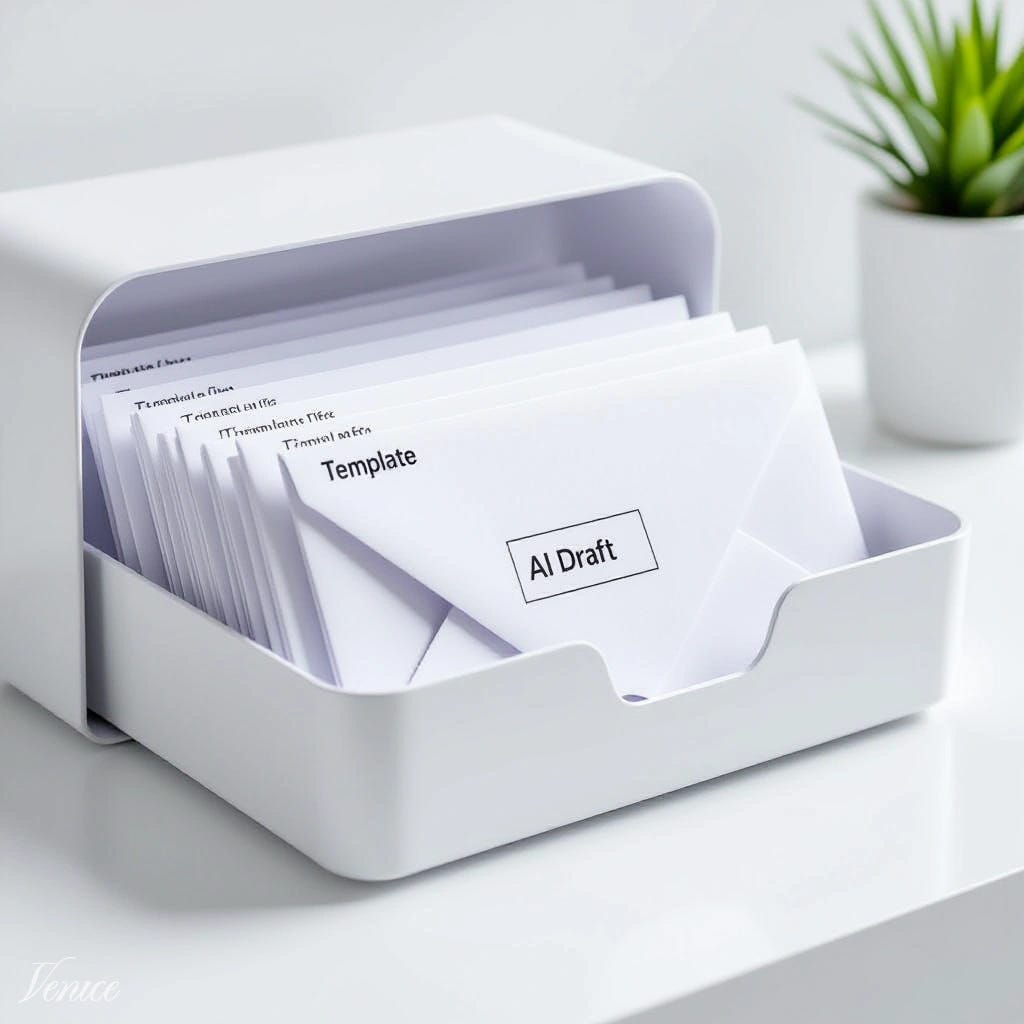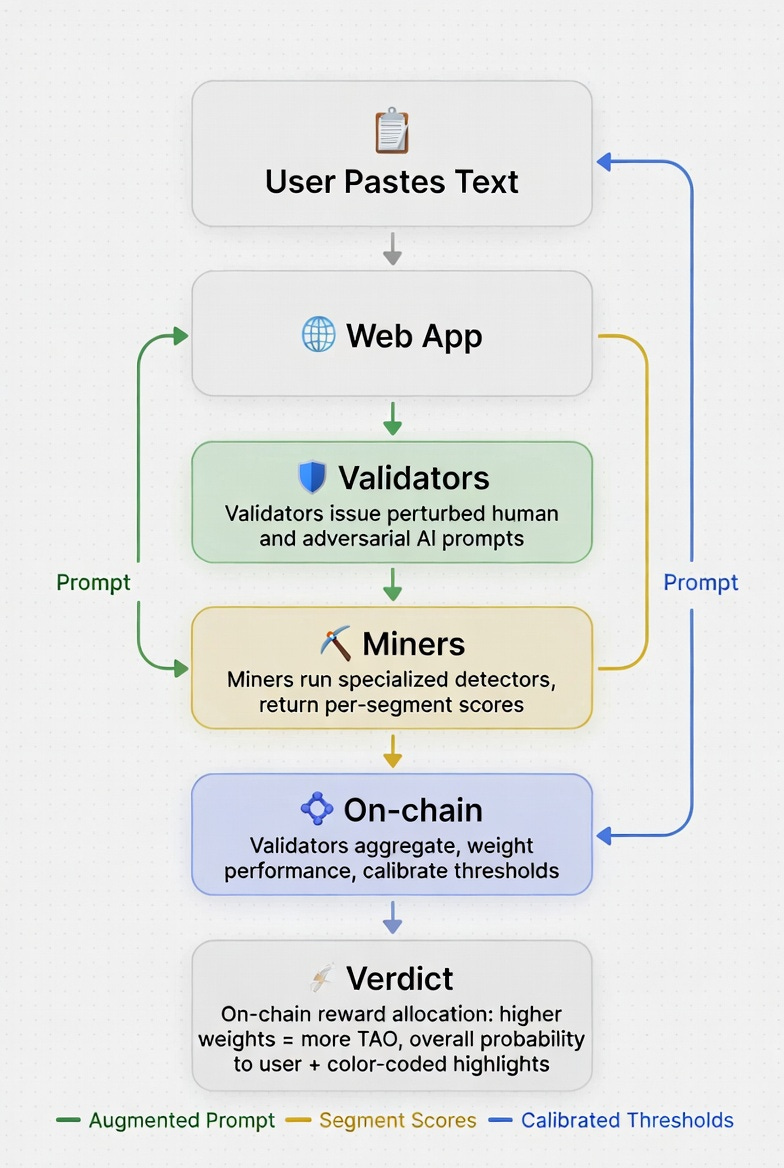The Text Truth Machine: Bittensor’s Subnet 32 Explained
Tired of AI slop? A decentralized way to spot synthetic text and keep your words yours.
I’ve got a confession.
I’m tired of reading AI slop everywhere.
It sneaks into my day like spam in a clean inbox.
Monday morning, I’m nursing coffee in my office when a C‑suite email lands.
Trying to look down to earth but a little too perfect, encouraging us all to “dream big” as they finalise their purchase of a new holiday home in The Hamptons.
By lunch, across my desk comes the annual review of my colleague who casually mentions she may have had some help with her submission this year.
For someone who once would have needed a translator for half of her emails (English is in fact her native language), she now unveils a flawless year-end performance review written by Chat GPT that reads like a TED talk speech given by Elon Musk on his annual achievements.
Later, I pass a coffee shop and watch students huddled over laptops, whispering prompts to each other like cheat codes.
And somewhere inside, I feel it tug at me too: why not let a model draft that tricky email? Save ten minutes here, nobody’s going to get hurt.
It’s seeped into everyday life: classrooms, inboxes, timelines. And once you notice, you can’t unsee it.
Why Not Outsource Your Voice to AI?
Using AI for everything feels efficient, but it erodes your voice, atrophies your writing muscles, and swaps sharp insight for safe, bland coherence.
Models can hallucinate, carry hidden biases, and leak sensitive information; detectors increasingly flag the telltale cadence, inviting scrutiny in schools and workplaces.
Unclear training origins and derivative phrasing can create copyright and disclosure problems, especially in regulated industries and academia.
As hard as it may seem, treating AI only as your drafting partner is still essential. Make sure the final cut is in your voice with your judgment and fingerprints on the page.
What Is “It’s AI” (Subnet 32)?
This is Bittensor’s decentralized detective for spotting AI-written text.
Paste a block of text into a simple web app, hit “analyze,” and within seconds you get a probability score with highlights showing which parts look synthetic.
That’s Subnet 32 in a nutshell, a decentralized AI detector built on Bittensor’s network.
Unlike centralized tools like ZeroGPT or GPTZero, which rely on a single company’s black-box algorithms, It’s AI crowdsources detection from Bittensor miners. These miners run specialized models that compete to provide the most accurate verdicts, rewarded in TAO based on validator scores.
It’s Bittensor’s incentive magic at work: better detection means more rewards, which drives constant improvement.
The subnet launched earlier this year and its real power is in practical utility: verifying content authenticity without trusting a gatekeeper. Just last month, the founder demoed the app on a Revenue Search interview, highlighting its focus on education and a clean interface.
How it works at a glance:
Miners (model providers) submit detection outputs on evaluator prompts.
Validators (judges) score miner outputs against augmented datasets (including perturbed/typo‑noised human text and adversarial AI text) to prevent “teaching to the test.”
Rewards are allocated on‑chain by performance weights. Diverse models are incentivized and collusion is disincentivized by Bittensor’s anti‑majority mechanics
Key Features: Beyond Binary Verdicts
What sets It’s AI apart?
1. AI Detection Focus:
Trains models to identify synthetic text, combating misinformation, spam, and bot-generated content in social media, academia, and beyond. Validators modify a massive database of 18 million human-authored texts (with tweaks like misspellings) to prevent miners from gaming the system, ensuring genuine innovation.
2. Segmentation and Explainability:
The tool breaks down text token-by-token, highlighting which parts scream “AI” (e.g., robotic phrasing or patterns). Essential for writers, students, or journalists who can edit just the flagged bits to humanize their drafts with minimal changes.
3. Industry-Leading Accuracy:
On benchmarks like RAID (https://arxiv.org/abs/2405.07940), it hits 95.7% accuracy, topping both commercial and open-source rivals. Their unified benchmark paper, covering over 2 million samples from 15 datasets, boasts a 0.92 ROC score, outpacing rivals GPTZero.
4. Upcoming Features:
Plagiarism detection is in the works, making it an all-in-one integrity tool with room for complementary subnets to integrate. Expect separate scores for “AI‑likelihood” vs “source overlap” and not a blended mystery number.
Beyond Hype: Subnet 32’s Real-World Utility
It’s AI can be thought of as Bittensor’s decentralized fact-checker.
Miners are the detectives, running models to sniff out fakes; validators are the judges, scoring accuracy with augmented data to keep things evolving.
- Content Moderation: Filters fake reviews or automated comments, keeping platforms authentic.
- Academic Integrity: Teachers spot AI essays; students use highlights to refine work and support disclosure.
- Brand Safety: Businesses vet ad copy or avoid AI propaganda.
Contrast this with centralized tools: decentralized ensembles reduce single‑point failure, opaque policies, and silent model swaps. Open methods and auditable incentives make governance and drift visible.
It’s a trust layer that pairs beautifully with Bitmind (Issue 15) for visuals, text detection here, deepfakes there, building an “authenticity stack” for schools and brands.
The AI Gamekeeper vs. The AI Poacher
The fun part here is Subnet 32 actually serves both sides.
Teachers (gamekeepers) detect cheating; students (poachers) use highlights to humanize AI drafts.
Used well, it encourages better drafting habits and honest disclosure rather than concealment.
The team have niched into education, targeting the $250M US market for AI/plagiarism tools, with global growth to $2B by 2030.
Their B2B strategy is outreach to 4,000 US higher-ed decision-makers: scanning websites for AI flags, then emailing them with screenshots to spark a conversation.
Invoking my VITALS framework from Issue 17 (VITALS = Value, Interface, Traction, Access, Loyalty, Sales) Subnet 32 passes the stress test with flying colors: clear value signal (“The most accurate AI detector for texts”), no-login demo, good traction (top half emissions), integrations via API and sustainable pricing (credit card subs, no crypto needed).
Accessibility: The Feature That Empowers Human Writers
For non-coders, the magic is in the interface. Paste text, get a color-coded breakdown: green for human, red for robotic. It measures how “unsurprising” your wording is to models; too smooth can be a tell.
Monetization’s straightforward: B2C subs for individuals, B2B/enterprise for schools (via their Dubai-based company). And Bittensor’s permissionless ethos means anyone can build front-ends by adding dashboards, audit trails, or reports without asking.
How to Use It: A Dead-Simple Guide
No wallet, no TAO required for basics. Here’s the playbook:
1. Head to the Web App: Visit https://its-ai.org/en
2. Paste Your Text: Drop in a tweet, email, or article snippet (up to a few paragraphs).
3. Get the Verdict: Probability score (e.g., “85% AI”) with highlights.
4. Refine: Use the red highlights to edit specific sentences rather than rewriting everything.
My test: the opening paragraph of this piece scored “53% human”; an AI rewrite scored “98% machine.” Length and style matter and short texts are less reliable.
Why This Matters for Your Bittensor Journey (And Mine)
In an AI-saturated world—newsletters (cough), social media, academia: Subnet 32 solves trust without banning innovation.
Decentralization isn’t a buzzword here; it’s an operational advantage for adversarial environments: diverse models, transparent scoring, and incentives that keep the ensemble adapting.
It’s why I started this: making decentralized AI approachable one concrete tool at a time.
If you’re early in your Bittensor journey, Subnet 32 is a perfect first rep: verify a paragraph, edit the red bits, disclose your use and feel the difference when your work sounds like you again.
Pair it with Bitmind for visuals and you’ve built a simple authenticity stack you can use at school, at work, or in your brand.
I’ll keep turning the ecosystem into habits you can run this week; if you’re up for it, try one and tell me what broke, what worked, and what you’d like next.
Until next time.
Cheers,
Brian




